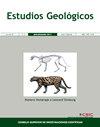下更新世晚期Quibas遗址马匹研究(Abanilla,穆尔西亚,西班牙)
IF 0.8
4区 地球科学
Q3 GEOLOGY
引用次数: 7
摘要
本文描述了在西班牙穆尔西亚的Quibas (Abanilla, Murcia)最新的早更新世岩溶遗址中发现的60多具马化石。研究了它们的分类形态、演化阶段和古生态决定因素。通过与其他西班牙和欧洲地区的不同形态进行比较的多变量分析表明,大多数化石与中等物种高马(Equus altidens)相符。这一种代表了窄尾类动物谱系的最后一种。在西班牙,E. altidens与温暖或暖温带气候有关,在林地或稀树草原-马赛克栖息地。Equus suessenbornensis也很少有代表,首次引用于Quibas遗址。本文章由计算机程序翻译,如有差异,请以英文原文为准。
Estudio de los caballos del yacimiento de Quibas, Pleistoceno Inferior final (Abanilla, Murcia, España)
In this paper, over 60 fossil horse remains from the latest early Pleistocene karstic site of Quibas (Abanilla, Murcia, Spain) are described. Their taxonomy and morphology, evolutionary stage, and paleoecological determining factors are studied. The multivariate analysis through comparison with different forms that occur in other Spanish and European localities shows that the majority of the fossils match the medium-sized species Equus altidens . This species represents the last form in the stenonoid lineage. In Spain, E. altidens is related to warm or warm-temperate climate, in woodlands or savanna-mosaic habitats. Equus suessenbornensis is also sparsely represented, first cited in the site of Quibas.
求助全文
通过发布文献求助,成功后即可免费获取论文全文。
去求助
来源期刊

Estudios Geologicos-Madrid
GEOLOGY-
CiteScore
1.40
自引率
14.30%
发文量
6
审稿时长
>12 weeks
期刊介绍:
Since 1945 Estudios Geologicos publishes original research works, as well as reviews, about any topic on Earth Sciences.
Estudios Geologicos is published as one yearly volume, divided into two half-yearly issues. It is edited by the Spanish National Research Council (Consejo Superior de Investigaciones Científicas, CSIC) at the Instituto de Geociencias (CSIC-UCM).
Estudios Geologicos provides free access to full-text articles through this electronic edition. Accepted articles appear online as "Forthcoming articles" as soon as the galley proofs have been approved by the authors and the Editor-in-Chief. No changes can be made after online publication.
 求助内容:
求助内容: 应助结果提醒方式:
应助结果提醒方式:


